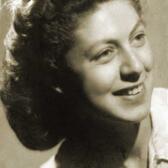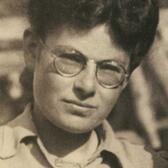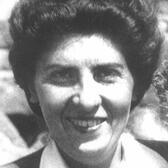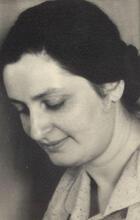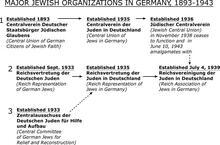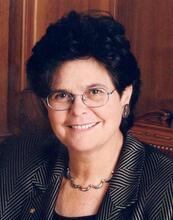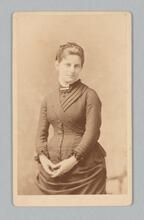Resistance, Jewish Organizations in France: 1940-1944
Despite the fact that women did not hold a high status in prewar French society, Jewish women played a disproportionately large role in the French resistance against the Nazis. Hundreds of women protected their fellow Jews, especially Jewish children, from the Nazis. This article profiles eight extraordinary women: Margot Cohn, Marianne Cohn, Madeleine Dreyfus, Denise Gamzon, Ariane Knout, Mila Racine, Andrée Salomon, and Juliette Stern. Each of them heroically saved Jewish lives, and some of them paid the ultimate price for it.
Jewish Women Before the War
In terms of numbers, the proportion of Jewish women active in Jewish underground organizations in occupied France is impressive. A lexicon of French-Jewish underground organizations published in Paris in 2003 contains a brief biography of every single member of the organizations, with emphasis on her or his actions in the underground. Of some six hundred members, two hundred and forty—approximately forty percent—were women.
This statistic is surprising, since women’s status in France lagged behind that in other countries. The advisory council founded by General Charles de Gaulle in Algiers granted French women the right to vote only on July 23, 1944. On the eve of World War II, the number of French girls who held a matriculation certificate was much lower than that of boys, and the same was true of women university graduates, none of whom studied medicine. Members of the middle class usually did not care much about the education of girls, whose sole future would be as homemakers. In this respect, French-born Jews, most of whom belonged to the middle class, were no different from their non-Jewish counterparts. The exceptions to this rule were the children of immigrants from Central and Eastern Europe.
The leaders of the Jewish organizations were all men, though every religious community had a women’s organization in charge of charitable funds. No women’s organization in the strict sense of the word existed at the time, except for a branch of WIZO in Paris, headed by Juliette Stern, who was both politically and socially aware.
With the unique exception of WIZO, women active in the public and in the community were counselors in the youth movements and paid employees in offices and in social-service offices. Yet no women were among the decision-making leaders except for Denise Gamzon, who was on the board of the Jewish Scouts movement in the 1930s.
The situation in organizations in which the Jewish immigrants were members is unclear since there has been no research on the topic. The major goal of these organizations was mutual aid, and they were identified by their members’ city or area of origin. In the 1930s more than 170 such organizations (landsmannschaften) were active, and most were of a political nature. Approximately ninety of the organizations joined the Federation (FSJF), which supported Zionism and the Socialist party (SFIO), while fifty others joined the Union des Sociétés Juives (USJ), which was loyal to the Communist Party (PCF). The best-known leaders, whose names appeared in countless Yiddish-language newspapers and periodicals (approximately 130), were men.
The Rise of the Underground
In view of these data, the question is how there arose such a large number of women activists who took on responsible and crucial roles in the Jewish underground. There is no evidence of a feminist world view in Jewish circles in the pre-war era. However, the occupation caused collapse or disruption in a large segment of the organized Jewish community. During that period approximately 120,000 Jews, including the members of the leadership, fled from the north and became refugees in the south. They were dispersed throughout hundreds of communities where Jews had never before lived. In many of these they improvised temporary communal institutions. The national organizations, such as the communities’ umbrella organization, the Federation and ORT, opened new main offices in one of the large cities of the southern region (Marseilles, Lyon and so on).The leaders of the Jewish Scouts movement showed initiative, establishing branches in every community where there was a relatively large concentration of Jews. Other youth movements resumed activity in 1942.
Like the unexpected events that caused tens of thousands of Jews to flee from the north to the south, creating a situation for which no one had planned, the resumption of Jewish public activity similarly occurred without prior planning and was completely improvised. This process was made possible by the appearance of people, including quite a few women, who had not previously been among the leaders’ group but now displayed a welcome initiative and spirit of volunteerism.
An example of this phenomenon is the story of the evacuation of the children from Paris. On the eve of the outbreak of war, the authorities announced that due to the risk of aerial bombardment in the capital they would evacuate children from distressed neighborhoods to places of refuge. This action was intended only for the children of French citizens and did not include the children of immigrants. The leader of the Jewish Scouts, Robert Gamzon, decided that the movement would carry out the evacuation of Jewish children of needy immigrant families. However, all the movement’s leaders and counselors had been drafted when the war began. The women counselors, led by Robert Gamzon’s wife, Denise Gamzon, completed the evacuation. As a result, several children’s homes were opened in southern France which played a crucial role later on, when the persecution of Jews began.
When German troops invaded French territory, the men of draft age were in the army. Since many of them were taken prisoner, the resumption of Jewish public activity necessitated the qualitative and quantitative participation of women, far beyond all previous levels.
Thus the advancement of women to fill high-ranking public positions in the Jewish community was clearly spontaneous, the result of unforeseen circumstances. As the persecution of Jews increased, so did the number of organizations that went underground. This included the youth movements. From the second half of 1942 their major activity centered on protecting the Jewish population and saving it from arrest and deportation. As far as possible, women were sent on missions that required exposure by traveling on public transportation or being in public places. The reason for this was simple: it was easier for women to disguise themselves as Aryans because they bore no mark of recognition on their bodies. Moreover, from the day that the order to switch to military struggle was broadcast on the radio from Algiers and from London in May 1944, most members of Jewish underground organizations joined partisan units, while the women took all responsibility for rescue work upon themselves.
One statistic illustrates the significance of women’s immunity relative to men’s during underground activity. The number of total losses—men and women members of the underground who were arrested, deported, murdered and/or fell in the line of duty—reached 191. Of these, 25 percent were women. A comparison with the proportion of women members of the underground—40 percent—confirms that their casualty rate was lower than that of the men.
It is appropriate to emphasize that the process of the advancement of Jewish women in Jewish public affairs occurred within the general context of the status of women in the country. During the occupation, changes similar to those described above occurred in the general population of French women, though to a lesser extent. The scope of the suffering and the enormity of the dangers that afflicted the Jewish population were immeasurably more severe than those afflicting the non-Jewish population. Is this fact connected to the rate of the advancement of women in filling public roles? While this question, which has not yet been examined, is beyond the scope of this article, two facts deserve mention. The decision to grant women the right to vote was made at the height of the war, as mentioned above. This is no coincidence. The number of women who merited the title of Righteous among the Nations is higher than that of the men. This has nothing to do with fulfilling public functions. The title of Righteous among the Nations is awarded to those who performed an action involving civic and moral responsibility while violating the law and placing themselves in great danger. In traditional society, women do not make decisions or initiate activity to rescue the oppressed and persecuted. Thus, the participation of women in the rescue of Jews may be seen as an indication of women’s advancement in society.
The process that began during the occupation did not cease with the liberation of France. Today, there is no longer any inequality between men and women in education and professional training. The male monopoly in the leadership field is waning, though the rate of women’s advancement is relatively modest.
Research has shown that the specific subject that sets the Jewish underground organizations in France apart is the rescue of children. The achievements of these organizations in this particular area are extremely impressive. This seems to have resulted from several factors, the most prominent among them being the enormous extent of women’s participation both in decision-making and in carrying out missions for the underground organizations.
Margot Cohn
Margot Cohn was born on July 14, 1922, in Ingwiller, France. Her father Jonas Kahn (b. 1880 in Weinbourg, France, d. 1940) was an accountant. In 1920 he married Mélanie Klein (b. 1893 in Niederroedern, France, d. 1983). In addition to Margot they had a daughter, Denise, who was born in 1929. Margot trained to be a librarian and in 1945 married Jacques Cohn (1916–1974), an educator. The couple had three children: a son, Elie (b. 1947), Ruth (b. 1948) and Daniel (b. 1950).
When the German army invaded France, the Kahn family fled from Alsace to the south. Young, modest and quiet, Margot volunteered in the Orthodox youth movement Yeshurun, which established a center for producing study sheets on Jewish subjects, to be sent by mail from Limoges. Cohn worked in the office of the main branch.
In 1942 the movement sent her to serve as a counselor in the children’s home that opened in Ussac in the Corrèze department. She worked there until the home was shut down and the children dispersed because of the danger of arrest. At that point Andrée Salomon, who coordinated the underground activity of the Jewish children’s aid society Oeuvre de Secours aux Enfants (OSE), contacted her and sent her to Lyon. There Madeleine Dreyfus, who was in charge of the OSE branch, gave Cohn the task of finding safe houses for young Jews and visiting the former residents of the children’s home, who were now in hiding.
Cohn worked with a constant awareness of the danger that threatened her, especially after Madeleine Dreyfus was arrested and deported to Bergen-Belsen in November 1943. She continued her tasks without letup, displaying superb spiritual and educational capacities in dealing with the children in their hiding places. The friendships formed during that time grew stronger even after the war.
In spring 1944 Salomon sent Cohn to accompany groups of children on the train from Lyon to Toulouse. Her task was to take them from their hiding place to another member of the underground so that they could be smuggled into Spain and from there to Palestine. Though it was painful for her to part with those of her comrades in the underground who were arrested or who joined the partisans, she never allowed this to interfere with her work.
Before The Jewish New Year, held on the first and second days of the Hebrew month of Tishrei. Referred to alternatively as the "Day of Judgement" and the "Day of Blowing" (of the shofar).Rosh Ha-Shanah 1944, which fell several days after the liberation of Lyon, Cohn succeeded in finding a Jewish family to host every one of her thirty charges. The day after the holiday she did a daring thing: without approval or cover from anyone she and Gaby Wolf, her comrade in the underground, rented an empty house in La Mulatière, a southern suburb of Lyon. They paid one month’s rent out of their own pockets and improvised lodging for the thirty youngsters so that they would not have to endure the discomfort of returning to the institutions and families that had taken them in before, where they had to pretend they were not Jewish. Though the leaders of the OSE reprimanded Cohn and Wolf, they retroactively approved their act and made sure that the children would be spared any suffering.
Marianne Cohn
In 1943, Marianne Cohn, an accountant born in Berlin, was sent by the Zionist movement Mouvement de la Jeunesse Sioniste (MJS) to replace Mila Racine after the latter’s arrest. Cohn was already active in producing forged passports for the underground MJS, nicknamed “physical education.” She smuggled many groups of youngsters to Switzerland until she, too, was arrested on May 31, 1944, together with a group of twenty-eight children ranging in age from four to fifteen. All of them were sent to Annemasse. The Jewish members of the underground prepared a plan to rescue her but she refused, lest her escape result in tragic consequences for the children. The members of the underground sent a message to the Gestapo, threatening to kill them if the detainees were harmed. Though the children were rescued, Marianne Cohn was kidnapped by members of the special services from Lyon on July 3, 1944, severely tortured and murdered in Ville-la-Grand, near Annemasse.
Madeleine Dreyfus
Madeleine Dreyfus (née Kahn) was born in Paris in 1909 to an assimilated family. After graduating from high school, she cultivated contacts with the Surrealists (André Breton and Jean Cocteau), married Raymond Dreyfus, a businessman, in 1933, bore three children (Michel [b. 1934], Jacques [b. 1937], and Annette [b. 1943]), and began to study psychology. In 1941 her family fled to Lyon, where the director of the Lyon branch of the OSE, Böszi Hirsch, invited Dreyfus to work with her. Dreyfus took upon herself the task of searching for families and institutions willing to take in Jewish children and young people. Neighbors referred her to the mountain village of Le Chambon-sur-Lignon. There she became acquainted with the spiritual leader, the Protestant minister André Trocmé, his wife Magda, and the village residents, all of whom actively supported her mission. For two years, Dreyfus often made the round trip between Lyon and Chambon, accompanied by children with whom she remained in contact.
From August 1942, with the first wave of arrests in the south, Dreyfus’s acts became illegal and the danger to her increased with the German occupation of southern France in November 1942. Yet these underground conditions did not deter Dreyfus from her indefatigable work.
Sometimes it was necessary for a child to stay for a few days at the institution for deaf people in Villeurbanne, near Lyon. On November 23, 1943, Dreyfus learned that the Gestapo were planning to raid the institution. She hurried to rescue a Jewish child staying there, but the Germans had preceded her and she was arrested. At this time she was nursing her two-month-old daughter Annette. Keeping her wits about her, she employed a ruse to warn her family to flee their apartment and go into hiding immediately.
Madeleine Dreyfus was deported to Bergen-Belsen, where she was liberated in May 1945. In 1947 she was awarded the Médaille de la Resistance. A psychologist at OSE and in private practice, she was among the founders of the Institut de formation et d’études psychosociologiques et pédagogiques (IFEPP) in 1963.
Denise Gamzon
Denise Gamzon was an only child born in Paris on April 26, 1909. Her merchant father, Maximilian Lévy (1872–1946), was born in Mulhouse, Germany (Alsace), but in 1882 the family, which included three other children, moved to Montbéliard, a small town in the Doubs region of France, possibly in order that the two sons should not have to serve in the German army. The oldest of the children, Isidore, born in 1871, was a brilliant scholar in history, Hebrew, and Greek, who became a professor at the Collège de France, one of the country’s most distinguished institutions of higher learning. Maximilian was first apprenticed to a cloth merchant. In 1890 he went to Brazil, worked for a while in a number of French-owned shops, spent six months in São Paulo, returned to Rio de Janeiro, and caught yellow fever, which left him weakened for the rest of his life. Back in France in 1895, he worked for export firms. In 1908 Maximilian married Sophie Lévy (b. Rouen, France 1886; d. Israel, 1972), who had a bachelor’s degree in German language and who gave private lessons.
On August 4, 1930 Denise Lévy, who had a master’s degree in German literature and was a counselor in the scouting organization Les Eclaireurs Israélites de France (EIF). She married the founder and director of the movement, Robert Gamzon (1905–1961), an acoustics engineer, whose mother was the daughter of Alfred Lévy, the chief rabbi of France (1907–1909). In 1934 she was the secretary of the International Committee for Refugee Intellectuals and in 1936 worked for both WIZO and the Jewish National Fund. A woman with strong left-wing political leanings, Denise supported both the Zionist movement and the movement for social justice. Upon joining the EIF leadership, known as the Conseil National, she became the first Jewish woman in France to hold a high-ranking position in a community institution.
When World War II broke out and her husband was drafted together with most of the male members of the movement, Gamzon coordinated the evacuation from Paris of the children of needy Jewish refugees. While the authorities evacuated the children of holders of French citizenship, the EIF decided to take responsibility for the fate of the children of Jewish foreigners.
The plan included opening children’s homes in the country districts of southern France, establishing technical and educational teams to operate them and, of course, fundraising—of which Gamzon was in charge—in order to finance the entire project. In the summer of 1940, after France was defeated and the movement’s members demobilized, they opened a number of farms. Gamzon was appointed as the director of the agricultural center in the village of Lautrec in the Tarn district, which comprised a hakhsharah and two farms. At the beginning of the summer of 1942, the center took in three Jewish boys and a group of thirty Jewish girls, all of whom came from the internment camps. When Gamzon learned of their impending arrest in August 1942, she went into action, guiding the children to a hiding place in the nearby forest and arranging a smuggling route for the girls until they were taken into permanent hiding places, some of them in Switzerland. In December 1942, when Gamzon was about to give birth to her third child, she was released from her position as director of the agricultural center but continued to work as part of the EIF’s underground, known as “the sixth”, which engaged primarily in hiding adolescents.
After the war, together with her husband, who had joined the Maquis in 1944, Gamzon established the Gilbert Bloch College for the training of young leaders in Orsay, in the suburbs of Paris. With their four children (Lilette [Lia], b. 1931, Daniel, b. 1932, Elie, b. 1943 and Myriam, b. 1944) and a group of their students, the Gamzons emigrated to Israel in 1949 and first settled in the religious A voluntary collective community, mainly agricultural, in which there is no private wealth and which is responsible for all the needs of its members and their families.kibbutz, Sde Eliyahu, and then in Nir Etzion. In 1953 they moved to Herzliya.
Robert worked as an engineer, while Denise taught French at high schools of the Alliance Israélite Universelle in Ramat Aviv. In 1959 Robert was engaged by the Weizmann Institute in Rehovot. After his death in September 1961 Denise began teaching at Tel Aviv University. In 1970 she successfully gained a doctoral degree with honors from the Sorbonne for a thesis on “Aspects of the Old Testament in the Poetic and Dramatic Works of Paul Claudel.” She retired from university teaching in 1977, moved to Jerusalem in order to be near her daughter Myriam, published her memoirs in 1997, and died at the Hod Yerushalayim retirement home on October 26, 2002.
Ariane Knout
Ariane Knout, the daughter of the Russian composer Alexandr Scriabin (1872–1915), was born in Italy in 1906. After converting to Judaism she married the Jewish poet David Knout. In June 1940 the couple fled Paris and went to Toulouse, where they established a secret organization called La main forte (The Strong Hand), the purpose of which was to prepare for the war against Britain in order to liberate Palestine. Ariane Knout went so far as to think that Hitler’s victory would strengthen the Zionist movement, allowing the Jewish people to put all its effort into establishing an independent state. The secret organization spread, eventually changing its methods and working for the establishment of an armed Jewish underground to fight against the Germans, with the name Armée Juive (AJ, the Jewish Army). In 1943 groups of AJ partisans were established. Knout kept communications open between the command in Toulouse and the partisans who trained in the forest in the Tarn district. She also brought weapons to the partisans and encouraged them with her enthusiasm for the struggle.
Ariane Knout was murdered on July 22, 1944, when she was ambushed by members of the French militia as she was returning to the AJ headquarters.
Mila Racine
Mila Racine was born in Moscow on September 14, 1919, but immigrated to Paris together with her family. She was a member of the WIZO group for young women in Paris. On the eve of the occupation of the city by the German army, the family fled to southern France. Simon Lévitte, the director of the EIF scouting movement, brought Racine to work in the documentation center he established in the town of Moissac (in the Tarn-et-Garonne depertment), near the youth movement’s dormitory. When the south of France was occupied in November 1942 and Lévitte moved the documentation center to the city of Grenoble (Isère), in the Italian-occupied area, Racine also moved to Grenoble.
From that time the documentation center was operated both by the EIF and by the Zionist movement MJS. After the Germans overran the Italian-occupied area in September 1943, the MJS assembled a group of activists who volunteered to smuggle children and young people across the Swiss border. Racine was a major activist in the group, but on October 21, 1943, she was arrested by the German border police together with the children she was guiding. All of them were taken to the Gestapo compound in the city of Annemasse, adjacent to the border. She succeeded in concealing her Jewish identity and was deported to Ravensbrück. The children were rescued by members of the underground.
On March 30, 1945, Mila Racine was killed in an Allied aerial bombardment of Ravensbrück.
Andrée Salomon
Andrée Salomon was born on May 25, 1908, in Grussenheim, Germany (Alsace), where both her father, Jonas Sulzer (1872–1915), a butcher, and her mother, Marie Geismar (1873–1962) were born. Her parents, who were married in 1901, had four children other than Andrée: Renée (1902–1941), Céline (b. 1904), Marcel (1906–1993) and Henriette (1910–1996).
Andrée attended the Jewish elementary school in Grussenheim and a high school in Colmar. In 1931 she married Tobie Salomon, a fuel engineer, who was born in 1898 and died in 1987. The couple had one son, Jean (b. 1948).
Prior to the outbreak of World War II Andrée Salomon worked in a law office in Strasbourg. She was active in EIF, the Jewish scouting movement, and supported the Zionist movement. The morning after the pogrom of November 9 and 10, 1938 (“Kristallnacht”), Salomon learned that the director of the Jewish orphanage in Frankfurt-am-Main wanted to transfer the children in his care to France. She obtained approval from the Ministry of the Interior and persuaded the Jewish aid organizations in Strasbourg to cover the expense of absorbing the refugee children. On December 6, 1938, the group of activists, led by Salomon, took in fifty-two Jewish children aged eleven to fourteen and referred them to foster families in and near the city. On April 24, 1939, a similar group of children from Karlsruhe was taken in. These were the starting points of a life’s work dedicated to rescuing Jewish children.
When the war broke out, Salomon fled with her husband to Clermont-Ferrand after finding refuge for every one of the children rescued from Germany, with whom she kept in touch during and after the occupation.
After the defeat of the French army and the accession of the Pétain government in 1940, Salomon joined the children’s rescue organization OSE, drawing the organization’s attention to the fate of families and especially of children imprisoned in internment camps in the south of France. She succeeded in recruiting activists to carry out a plan to rescue the greatest possible number of children from the camps and absorb them, as a first stage, in dormitories opened and operated by the OSE. Thanks to endless appeals to the government to the point of harassment, Salomon obtained approval to evacuate groups of children to institutions outside the camps. Thus, on February 26, 1941, forty-eight children aged four to fourteen were transferred from the Gurs camp to a government institution for war orphans, from which they were sent to various Jewish institutions. The dramatic parting from their parents was made possible by Salomon’s skill at persuasion. Activists of the OSE and the EIF were present in the camps as “social workers” who worked under Salomon’s guidance. At the same time, she worked tirelessly to carry out a complicated operation to assist several dozen children to emigrate to the United States.
In the summer of 1942 mass arrests of Jews and deportations to the east began. The situation worsened in November 1942 with the German army’s occupation of southern France. Hundreds of children who had been rescued from the camps and absorbed into OSE and EIF institutions were in danger of arrest and deportation. Salomon and the members of her teams went underground. Gradually, children were transferred to hiding places in non-Jewish families and institutions. Some of them—mostly those who did not speak French and those who had grown up in ultra-Orthodox homes—were smuggled to Switzerland. Salomon even put together a group of children who had relatives in Palestine, arranging for them to be smuggled to Spain via Andorra and from there to Palestine, while the war was at its height. Though they never saw their parents again, hundreds of children survived the Holocaust thanks to Andrée Salomon. Many of them regarded Salomon, who comforted those who wept and guided those who were confused, as their second mother.
Andrée Salomon served as deputy head of Israel Bonds in France from 1959 until her Lit. "ascent." A "calling up" to the Torah during its reading in the synagogue.aliyah to Israel in 1970. Beautiful, charismatic, and extraordinary, she became a living legend of whom it was said that in any place where the situation was desperate and people’s physical and emotional strength had run out, she would suddenly appear and find solutions, bringing hope, light and rescue. Her charges and colleagues in her heroic acts remained loyal to her and were in close contact with her until her death in 1985.
Juliette Stern
Juliette Stern was one of the comparatively small number of Zionist activists among French Jews in Paris. Her father, Louis-Jacob Sanjaard, was born in Borne, Holland in 1851 and in 1882 married Sophie Cohen (1856–1933). The couple emigrated to Paris, where Juliet was born on December 23, 1893. Her first husband, Waldemar Sylvain Hauer (b. 1886) died in 1916. Their daughter Simone was born in 1914. Juliette later married Robert Stern (b. 1881).
At the beginning of the 1930s Stern visited Palestine and upon returning home established a women’s club, Kadimah, which studied the history of the Zionist movement. In 1935 the club merged with another small organization, Jewish Women in France for Palestine, to establish a branch of WIZO, of which Stern was appointed director-general.
In January 1942, when the Office for Jewish Affairs (Commissariat général aux questions juives, CGQJ) under the Pétain government decreed the closure of all Jewish community institutions (except for religious communities) and their replacement by the umbrella organization Union Générale des Israelites de France (UGIF), Stern was appointed a member of that organization’s leadership. She took upon herself the management of Branch Number 5 of the UGIF.
Some of the children who were arrested and imprisoned in the Drancy camp together with their parents were handed over to the UGIF by the Germans. Branch Number 5 lodged them in one of the dormitories it administered. The children were defined as “stuck,” meaning that they could not be transferred to another location, since their final destination was back to Drancy and deportation. Branch Number 5 also dealt with “free” children, who were homeless for various reasons. The UGIF dormitories could house up to four hundred children, but Branch Number 5 had a larger number of charges. Instead of enlarging the dormitories’ absorption capacity, Stern decided, contrary to German orders, to transfer the children to non-Jewish families and institutions. Members of WIZO and social workers, several of whom were not Jewish, found hiding places for the children, ensuring their welfare and paying a monthly fee for their lodging. These activities were carried out in secret and at great risk. By using accounting ruses Stern diverted UGIF funds to meet expenses, in direct violation of official orders. Joseph Antignac (1895–?), the secretary-general of the CGQJ, suspected her and in spring 1943 contacted the commander of the Gestapo’s Jewish department, Heinz Röthke (1912–1966), asking him to begin an investigation. Instead of doing so, the Gestapo arrested the employees of UGIF’s Branch 5, including their manager, Joséphine Getting. All were deported and murdered.
At the time of the arrest, Stern was attending a funeral. After this tragic event, she collaborated with the members of the Jewish underground, arranging details of the “kidnapping” of the “stuck” children from the dormitories. However, at the end of July 1944 there were still children, including “free” ones, in the dormitories when the Gestapo arrested and deported two hundred and fifty of them.
WIZO was responsible for more than a thousand children, all of whom were saved, as were those who were “kidnapped” by the Jewish underground.
Braumann, J., G. Loinger and F. Watterberg (eds.). Organisation juive de Combat. Resistance/Sauvetage. France 1940–1945. Paris: Éditions Autrement, 2002.
Hammel, Frédéric C. Souviens-toi d’Amalek. Paris: CLKH, 1982.
Lazare, Lucien. Rescue as Resistance. New York: Columbia University Press, 1996.
Marrus, Michael R. and Robert O. Paxton. Vichy France and the Jews. New York: Basic Books, 1981.
Poznanski, Renee. Etre Juif en France pendant la Seconde Guerre mondiale. Paris: Hachette, 1994.
Zuccotti, Susan. The Holocaust, the French, and the Jews. New York: Basic Books, 1993.



